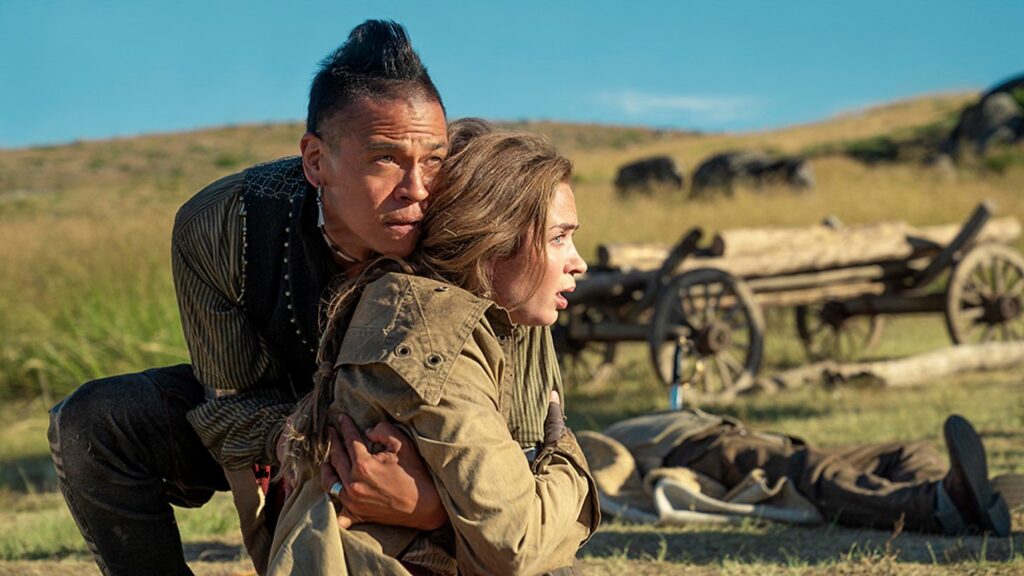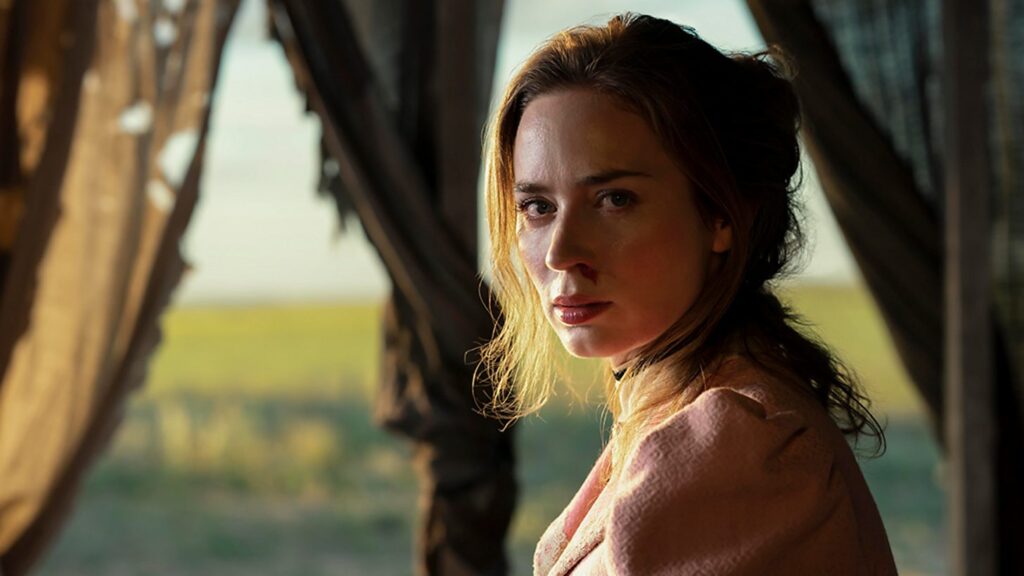*
PRESS RELEASE SOURCE: BBC
*
Describe the plot of The English in 15 seconds.
It is Alice in a wild west Wonderland. Cornelia Locke arrives to seek revenge for her son’s death. She seeks the help of a Pawnee warrior played by Chaske Spencer, and together they go on this epic adventure.
*
Why do you think The English will resonate with a global audience no matter where in the world they are?
The English will resonate with a global audience no matter where they live because, don’t we all need that wide screen epic adventure classic? I think we all look for that kind of escapism, to be swept away and kidnapped by a world, and this is that world.
*
How did you come to be part of this project and what interested you the most on reading the scripts?
I was sent the pilot and I knew it was a Western, which I’d never done before, so I was compelled to read it. I read the first page and I knew I was doing it from her first monologue. I felt completely kidnapped by this world. I called my agent after page two, and I said, ‘I think I’m going to be doing this show’. I was so struck by it.
*
Why do you think it is important to tell this story now?
I think it’s an important story to tell because most of us go through life trying to figure out what our identity is. This is a story about identity, about reclaiming that for yourself. It’s about self-discovery, and I think everybody can identify with that. A lot of people have been through something traumatic, and valiantly stepped forward, and I think people will see themselves in these characters.
*
Can you describe The English to the audience?
The English is an epic romance – and at the same time, it’s this propulsive chase thriller, so the whole experience of watching it is heart racing and very romantic.
Cornelia is seeking a blood revenge, and Eli is seeking a land claim. They both see these end goals as being a part of reclaiming their identity, and an awakening for themselves.
*

*
What are the key themes explored in The English?
I think revenge and identity are, at its core, the main themes. You’ve got Cornelia’s character, who is seeking a blood revenge, and if she’s able to carry that out then she sees a reclaiming of who she is. And you’ve got Eli Whipp, who’s just seeking a land claim. It sounds simple, but that is his way of reclaiming his identity after leaving the U.S. army and all the atonement of guilt he has to go through. But tonally, the story is told in this very intimate way that’s funny, violent, but also epic. We haven’t seen that for a while, something so epic and so beautiful with something that has modern intimacy to it.
*
There are many challenges on this journey for Cornelia, both emotional and physical. What does she discover about herself when faced with these?
She looks like a complete fish out of water when she first arrives. She’s in this beautiful pale, lacy, pink dress. She is gussied up and looks ill-prepared for what awaits her in this dust-ridden, violent, masculine world. Her costumes, and how they go from pink to red to purple, are like the bruising of her journey that she goes on, that’s symbolised in what she wears. Even though the journey is something that frays her physically, she emotionally grows so much, and it’s like an awakening for her. It’s an awakening of who she is.
When you first meet her, you think “oh, she is never going to make it, it’s over”. By the end, she’s had this remarkable transformation.
*
*
What she discovers about herself is that she’s a force to be reckoned with. It is a voyage of what she’s truly capable of; the violence, the revenge, the physical duress and trauma that she can overcome.
There are certain scenes I remember being particularly fevered, which were the ones I had with Rafe Spall, who plays the baddie. He was just so dangerous in the scenes that I remember finding them very transporting and hard to shed afterwards. Those scenes are important because they’re integral to understanding her backstory and why she is the way she is.
*
Can you tell us about your preparation for the shoot? It is obviously a very physical role with many stunts and much time spent on horses.
I always love the physical preparation because it puts you in the body of this person. I’d always ridden as a kid, but not to this extent, and not with this ability. I trained for four months before we did it, and I would ride two or three times a week. When we got to Spain, we were on horses all the time and we had the most beautiful horse master, who was like a gentle conductor and horse whisperer. The horses are so extraordinary. They’re like artists, they’re incredible. My horse, Ethos, became my little soul buddy. I was very sad to leave him. It was a beautiful relationship at the end.
*
There is an incredible cast attached to the series. Could you describe your experience working with Chaske Spencer?

Chaske plays Eli like it’s a Paul Newman role, it’s very striking to watch him. The character is so beautiful because he’s weighed down by sadness, he’s closed off, and she comes along and moves it all around and wakes him up. I love seeing him unfurl in that way. He is the kind of actor who can do nothing and you lean in, you’re riveted by him. He’s completely captivating. He’s got this stillness that was so regal and beautiful to watch.
*
Could you describe your experience working with Rafe Spall, Ciarán Hinds and Valerie Pachner?
I’ve always been such a fan, but Rafe came into this show like a dangerous Ferrari. It was just lights out, brilliant. His character is very lethal, he’s scary. Ciarán Hinds was such a hoot! We had such a joy doing this scene where he plays a horrible character, but we had such a laugh doing it together. I loved working with Valerie Pachner. She’s such a formidable actress. She’s so special and such a force because she has this steeliness to her in the character, and a ferocity that’s needed for Martha. It was beautiful to see the character’s cracks forming over the course of the story, to see the vulnerability of someone who has also suffered a great deal. There are a lot of characters who have suffered something traumatic in this and have chosen to move forward in a valiant way.
*
*
Could you describe your experience working with writer-director Hugo Blick?
Hugo Blick and I would speak quite a lot about casting. He had a very free rein with whoever he wanted, but he would ask me what I thought for the integral parts that I would be working with – Chaske being the most important one, he wanted to make sure we all felt we’d found our Eli. I trust Hugo’s opinion on everything, to be honest with you, so I think that if he’d liked someone and thought someone was great then I’m sure I was going to feel the same.
The thing that stays with me about Hugo is that yes, he wrote this, he birthed this idea, and you can’t believe one man came up with such a dexterous and stunning world – but then, as a director, he didn’t cling on to it tightly. That was what was so refreshing because normally a writer-director has a tight grasp on it, and you feel you’ve got no wiggle room with the material as an actor. I think he realised early on that she was mine now, he was Chaske’s now. There was a gracious handover. Genuinely, I think every day he was waiting to see what I’d do, and I felt such freedom in that.
Hugo’s writing is completely singular. It’s epic, and yet intimate. It’s romantic and operatic, and yet very funny. It’s dangerous, it’s violent. I hadn’t read something like that, that was so subtle and yet so symbolic.
*
Can you tell us about some of the wonderful locations you’ve been shooting in?
We shot in Spain, which was where they shot all the old spaghetti Westerns, and you can see why. The landscape is vast, and we needed different landscapes because the journey they go on starts in Kansas – in the flats, the dust – and it goes through Wyoming, into rocky, beautiful formations. Spain offers all of it.
The night was so beautiful because the sun would be setting, and with all the horses and the wagons and everything, it would kick up this dust that would add this eerie, beautiful, spellbinding look to the whole thing. It was like a dust bath, and I missed it when I came back to New York, to this concrete jungle.
*

*
How have you found shooting in Spain?
When we were there, we realised there was nowhere else we would rather have shot this. The crew was 95% Spanish, and one of the best crews I’ve ever worked with.
It was so hot. I have never been hotter than that in my life – and I’ve shot in Atlanta in the middle of the summer and thought I’d never experience heat like that. We were warned about it, but the corset acts like a heat trap, your skin doesn’t breathe. I’d be in a corset, wool pants, a skirt, shirt, waistcoat, jacket. I don’t think I ever got used to it.
*
Can you tell us a bit about your costumes and the collaboration with the costume designer, Phoebe de Gaye?
Phoebe is the most collaborative, emotionally driven costume designer I’ve ever worked with. She was so invested, intrigued, and interested in how I wanted to play her; “what do you feel about her?”, “why do you think she does that?”. I’ve never felt less of a clothes horse in my life. She said, “tell me emotionally where she’s at” and that’s what she’s led by which is why the costumes become emblematic of their journey and who they are. It’s not just because it looks cool or it’s a cool colour. When I first arrived there, she said “she should look out of place, right?” And, my god, she looks out of place in the pinkest dress you’ve ever seen in this stark, saturated landscape. She’s just visually so clever. That idea of her going to red, to a purple-y burgundy, is representative of the bruising of her journey, and Phoebe thinks of all these things. It’s just incredible.
*
If you would like to donate to help the 5D Pop Culture website, you can support us here: https://ko-fi.com/5dpopculturewebsite
*


